Lunar occultations of the brightest stars in the 2021-2040 period
The last piece of the topic about the most interesting celestial events in the period of 2021 – 2040 covers lunar occultations of stars. I haven’t described it before, because in my point of view, they are not as spectacular as they could be. In fact, this is only my point of view, therefore this type of occurrence cannot be ruled out. Another thing is the time when this article is produced. It’s in fact almost mid-2022, but the text predominantly describes lunar occultations of just the brightest stars, brighter than 2 Mag. It corresponds to all 49 brightest stars described recently, from which only 5 of them can be occulted by our natural satellite. Because the series of these occultations started in the next year, this article seems to be still just in time. However, I also would like to point out the sources, where you can chase the other star’s disappearance behind the Moon and plan appropriate observations.
1. INTRODUCTION
Lunar occultation of the star means, that the Moon is said to be found exactly in the straight line between the Star and Earth. This is usually a fast-moving event, because the Moon’s orbital velocity is around 3500km/s, and it appears to move through 0″.5 per second of time (Wlasuk, 2000). It finally takes the Moon to move its own width across the star beyond within up to one hour. The specificity of this type of occultation is that even a very bright star completely vanishes within a short moment behind the western limb of the Moon.

Pic. 1 The pattern showing the typical lunar occultation of the star considered for 3 locations, where: A – full occultation; C – graze occultation; B – no occultation takes place (Dunham, 2007, Asteroidoccultations.com).
Unlike lunar occultations of planets, which in fact happen quite rarely and randomly, occultations of stars occur often in series, which are repeatable as per precession of the lunar orbit. These series of occultations count at least a dozen or so events, which tend to repeat monthly (every lunar synodic month) in various regions of the surface of the Earth. With respect to just the brightest stars considered, the lunar occultations series includes between 20 and 70 events across the whole lunar nodal precession period. Similarly to lunar occultations of planets, we can also observe grazing occultations. In this case, unlike the planets, we won’t see the typical object “sets” and “rises” above the lunar disk. The stars are too small for an appearance such as this and they disappear and reappear intermittently at the edge of the Moon. Grazing occultations are almost always inherent events of any lunar occultation, but are much more challenging, as they refer to the location, where the alignment between the lunar limb and the star is just right. They can be observed solely only in the case when some series of occultations are vanishing completely (Pic. 2).
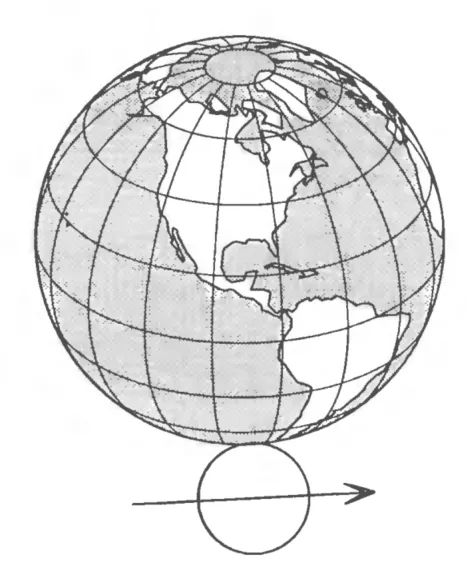
Pic. 2 The last occultation of Pollux on September 30, 110 BC was practically just a grazing occultation possible to see from Antarctica (Meeus, 1997).
By watching how the Moon’s northernmost or southernmost limb grazes the star, we can determine the local lunar topography, where we can i.e. calculate how many times the occulted star is blinking. Grazing occultation paths are usually uncertain, therefore spacing several observers along a line perpendicular to the predicted path is a standard observation practice.
2. SCIENTIFIC BACKGROUND
Besides the visual profit of the star’s occultation by the Moon, we cannot forget about important scientific reasons, why observations such as these are really important.
A. Discovering the double stars – Lunar occultations are capable of separating the stellar components, that are only 0″.02 apart (Wlasuk, 2000). The best method, which allows astronomers to detect double stars this way is using video techniques. They can record exactly how the given star is occulted by moving the lunar limb. The most important moment here is the so-called “step event”, which in fact results in the abrupt light drop, but not in total. Therefore the occurrence of this “step event” says, that the occulted star is actually the double star. The brightness of this star system goes to zero when the second star is occulted (Pic. 2).

Pic. 2 A perfect example of double star occultation by the Moon, where the “step event” is clearly noticeable (bounded red). The example refers to the Σ Scorpi occultation on August 14, 2005 (Occultations.org.nz).
The primary downside of double-star occultation by the Moon is its location in the sky, which cannot exceed over 5 degrees away from the Ecliptic line. According to astronomers, there are about 50% or even more double stars (or more advanced star systems) in the Milky Way galaxy.
B. Determining some parameters of the stars – at the moment of occultation, the light from the star is diffracted around the sharp edge of the Moon, which results in the characteristic oscillatory signal. In reality, the stellar light does not disappear monotonically, but the rays of stellar light are diffracted by the lunar limb according to Fresnel diffraction. The interference pattern depends on the angular diameter of the star (Bohm-Vitense, 1989)(Pic. 3).
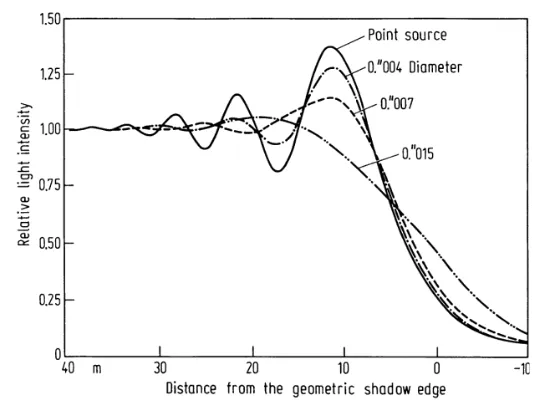
Pic. 3 The diffraction pattern for lunar occultations of stars of different angular diameters. Higher amplitudes of the oscillations correspond to smaller angular diameters (Roth, 1994).
By knowing the shape and duration of this oscillatory signal astronomers can acquire the diameter and surface temperature of the star. For example, an occulted star with a diameter of 0″.001 disappears in 1/50s (Chemin, 2019). This way of measurement can be applied i.e. for cool giant stars like Aldebaran or Antares and is deemed as one of the most powerful and cost-effective methods of high-angular resolution measurements of stars since the lunar speed and star’s distance is well known. The rapid event occurrence excludes most atmospheric-driven elements like distortion, twinkling, or scintillation. On the other hand, thanks to lunar occultation observers might be able to detect the dust shell around the star, which perhaps can help to determine the shape and structure of the star. It applies mostly to stars, which blow their surface material off due to strong stellar wind.
C. Measurements of Earth rotation – which are based on long-term observation periods, often referred to as the earliest observations of the lunar occultations in history. Comparing the results of all these observations helps to mark the long-term ΔT variation, which corresponds to the time of the Earth’s rotation. It was found, that Earth was rotating faster in the past. The primary explanation for this situation is, that Moon is receding from Earth by 3,8 cm every year, which is driven by tidal friction. It results in the increase of the orbital angular momentum of the Earth-Moon system, thereby the spin angular momentum of Earth decreases (Tanikawa, Soma, 2014). This process wasn’t known until the early XXth century when astronomers thought that Earth rotates at a constant speed. The oldest records of eclipses and occultations come from about 700 BC from the ancient civilizations of Babylon, China, Europe, and the Arab world. As of the 1600s, these types of observations became much more accurate, which simplified calculations of the pace of Earth’s rotation. Anyhow, the vast majority of the observations were carried out before the International Atomic Time was established in 1962, so it was the most accurate way of determining variation in the Earth’s rotation. By amassing all these observations the final slowing down the pace of Earth’s rotation was computed. The change in the length of the mean solar day increases at an average rate of 1,74ms per century (Stephenson, Morrison, Hohenkerk, 2016) but it fluctuates (Pic. 4).
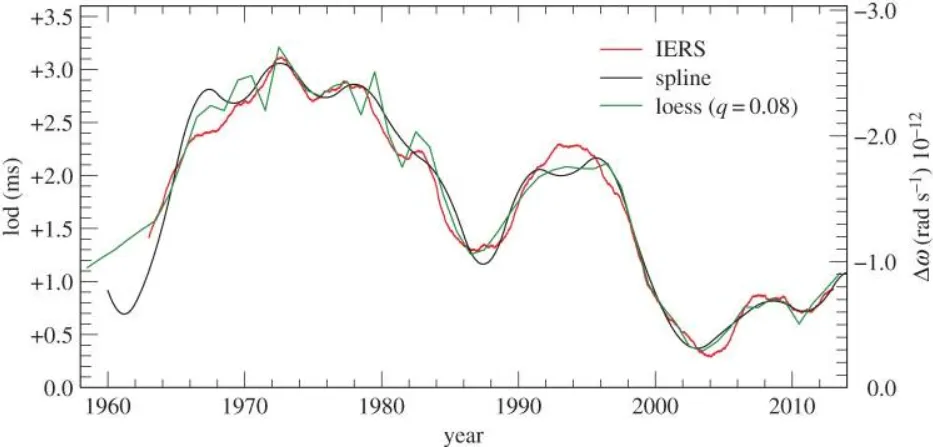
Pic. 4 The fluctuation of Earth’s rotation. The length of the mean solar day changes across the years with increments between 0,5 and 3ms per century. These results are derived from lunar occultations between 1960 and 2015 (Stephenson, Morrison, Hohenkerk, 2016).
D. Lunar limb profile investigation – it’s fairly possible, especially during grazing occultations when an observer can get valuable information about the lunar topography near its current edge. During the occultation of the star by the Moon, we have a specific relation between the position of the star, the observer, and the Moon at the moment, when the star disappears or reappears on the lunar limb. A multitude of lunar limb observations during occultations results in conclusions about the libration depending on the profile. Observation of the lunar occultation can reveal the limb irregularities i.e. various limb slopes, which eventually have an impact on the starlight diffraction fringes described earlier in this article.
3. LUNAR MOTION BACKGROUND
The most important piece of the mechanism of the lunar motion around Earth is nodal precession. Nodal precession is otherwordly the movement of lunar nodes across the orbital plane with respect to the ecliptic plane. It marks the time when the ascending node needs to return to the same position as it was at the beginning. The ascending node must move through 360º relative to the vernal equinox. The direction of this precession is westward, which is opposite to the Earth’s orbit around the Sun and takes finally about 18,613 years. Lunar nodal precession is firmly related to the lunar standstill phenomenon, determining the extremal values of the lunar declination, which have been widely described in this article. However, for the purpose of this topic, I just would like to remind you briefly what this relation is. Namely, when the ascending node is located at the vernal equinox (autumn equinox for the southern hemisphere), the Moon reaches the extremal declinations, unlike the opposite situation, where these extremal declinations are suppressed (Pic. 5).
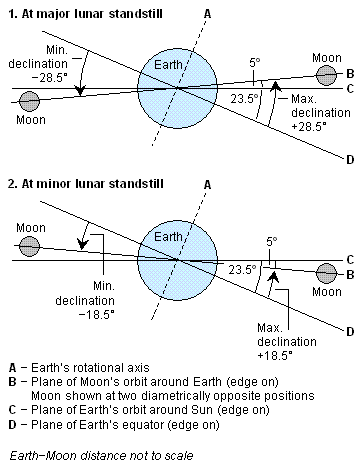
Pic. 5 Lunar standstill pattern (Wikimedia.org).
The mean inclination of the lunar orbit on the ecliptic is 5º08′,7 (Meeus, 1997), although it varies between 5º and 5º18′ (Pic. 6) because the motion of the nodes is not regular.

Pic. 6 The example of the instantaneous inclination of the lunar orbit on the ecliptic between 1996 and 1998 (Meeus, 1997).
The inclination reaches the highest value when the line of the nodes is directed to the Sun, which basically happens at each conjunction of one of the nodes with the Sun.
Because the Moon’s orbit is elliptic, it means, that sometimes this body is closer and other time is further to Earth. In fact, the major axis of the lunar orbit moves in the opposite direction to the nodes and makes the 360º rotation just within 8,85 years. However, in relation to a major lunar standstill, the most important moment occurs when the Moon is near its greatest (or smallest) celestial latitude and near its perigee. At a moment such as this, the Moon is able to occult these stars, which normally wouldn’t be able to occult. A situation such as this occurs every 183 years.
4. MATHEMATICAL BASIS OF THE OCCULTATION SERIES
The mathematical basis of the occultation series includes:
– The inclination of the lunar orbit – which means the value is 5º08′,7, although as it has been mentioned earlier it varies between 5º00 and 5º18,
– The apsidal precession of the lunar orbit – is important due to Earth-Moon distance variables. The general distance of the Moon to Earth varies between around 356500 and 406500km, therefore the Moon can’t appear always at the same size. Its angular size can vary between 28,5′ – 33,5′. The mean value assumed for lunar semi-radius is 15’32”,6 (Meeus, 1997). The major axis of the lunar orbit moves in the same direction as the Moon rotates.
– The nodal precession of the lunar orbit – lasts exactly 18,613 years. This is the time, in which the ascending node needs to move 360º. If we could split this speed yearly, we could gain roughly 19º21′ (Pic. 7).

Pic. 7 Movement of the lunar nodes, where: the central line ODN – ecliptic; O – vernal equinoctial point, N – ascending node, D – descending node, ON – longitude of ascending node (Meeus, 1997).
It means, that the star located nearby (or at) the descending node was occulted by the Moon on Jan 1, 1992, but due to the movement of the nodes, it wasn’t occulted exactly a year after. Nodal precession means also a variation of lunar equatorial declination, which is strongly related to the lunar standstill phenomenon. The most extreme declination of the Moon during a major lunar standstill can vary between -28º45′ and+28º45′.
– The parallax of the Moon – is seriously noticed across the Earth and its mean value is roughly 57’02”,6 (Meeus, 1997). The Earth’s diameter between the poles is 12725km. A distance such as this must cause a noticeable parallax, and of course, it does. As the celestial body is closer to Earth, the parallax is better visible. The parallax caused by Earth’s diameter is even noticeable in the case of our nearest neighbor planet – Venus. Moon is much closer, therefore we will see it apparently shifted between two different vantage points on our planet.

Pic. 8 Graphical explanation of lunar parallax (Meeus, 1997), where: E – the center of the Earth; P – vantage point at the north pole; L – grazing occultation of the star possible to see from the north pole; S – the position of the star as seen from the equator; X – the place in the space, where the star is occulted roughly by the center of the Moon (M).
Combining all these things together, in the vast majority of cases, the Moon can be able to occult the star located as much as 6º21′ away from the ecliptic plane. This is the sum of all the elements included here:
– the mean inclination of the lunar orbit – 5º08′,7
– the mean value of lunar parallax across the Earth – 57’02”.6
– the general angular size of the lunar radius – 15’32”,6
Considering the most extremal cases, which occur at intervals of 183 years, the Moon can be able to occur in the stars located as much as 6º36′ away from the ecliptic line, which corresponds to the following circumstances:
– the most extremal inclination of the lunar orbit – 5º18′
– the biggest value of lunar parallax across the Earth – 61″15′
– the biggest angular size of the Moon at perigee – 16’45”
5. OCCULTATION SERIES IN THE PERIODICITY OF LUNAR NODAL PRECESSION
As far as we know, within the lunar nodal precession, which lasts around 18,6 years the Moon can occult any star up to 6º21′ outside of the ecliptic plane. The location of the stars closer or further from the ecliptic will determine the number and length of the occultation series. In general, the situation looks as follows:
Tab. 1 The relation between the ecliptic longitude of the star and the total length of the lunar occultation series (Meeus, 1997).
Important is the threshold of 3º56′ ecliptic latitude. When the star is located further beyond this latitude, we can observe just one series of occultations per period of 18,6 years. For the stars that lie at the ecliptical latitude of +4º or -4º, we can experience a very long series of occultations, that last around 6 years. They are getting shorter as the absolute angular distance from the ecliptic line increases. For the stars that lie at the ecliptical latitude beyond +6º or -6º, the series of occultations aren’t essentially longer than just 2 years. The whole table (Tab. 1) above can be explained graphically by the image above (Pic. 7).
There is another correctness arising out of this situation. Each series of occultations starts from one of the geographic poles. By analyzing 2 series of occultations within the 18,6 years period, we can see two directions of these occultations occurrences. During the first series from one occultation to the next, the region of visibility moves from the first pole towards the other pole. During the second series, this region of visibility returns from its second pole to its first pole.
It does look different when watching just one series of occultations within the 18,6-year period. The occultations start from the pole and move towards another pole, which never advances. The region of occultation reaches its Earth’s latitude somewhere and next retreats towards the first pole again. In a case such as this, there are locations, from which the given series of occultations are never observed.
If the star’s latitude is positive (north), the series of occultations begin and end at the south pole. For stars at the southern (negative) latitude, the series begins and ends in the northern hemisphere.
6. OCCULTATION OF THE BRIGHTEST STARS IN THE FORTHCOMING 18,6 YEARS PERIOD
The forthcoming period of 18,6 years covers the 2021-2040 span indeed. As the lunar occultations of the brightest stars start in late 2023, we can assume the commencement of the lunar precession at the time of writing this article. The ascending node will reach today’s position in January 2041 as shown in the video at the end.
We have currently 5 stars brighter than 2 Mag, which are occulted by the Moon every 18,6 years period. The closest location to the ecliptic line has Regulus (0º28′), which means that in the whole period of lunar nodal precession, we can experience 2 series of occultations. They occur when the Moon’s path aligns almost perfectly with the ecliptic. If Regulus were situated roughly on the ecliptic, the middle of the occultation series would be separated roughly 9,3 years (18,6/2). But here we have the following relation, where the larger the star’s ecliptic latitude the more different the intervals between the middle of the series until the absolute ecliptic latitude of 3º56′ from which just one long occultation series occurs. Returning to Regulus, its middles of the occultation series are separated by 8.7 and 9.9 years (Meeus, 1997).
The first series of the lunar occultation of Regulus will occur from 2025 to 2026, and the second one about 9 years later (Pic. 9). Regulus is the 21st brightest star in the night sky. The series of occultations includes between 16 and 20 events including also daily occultations.
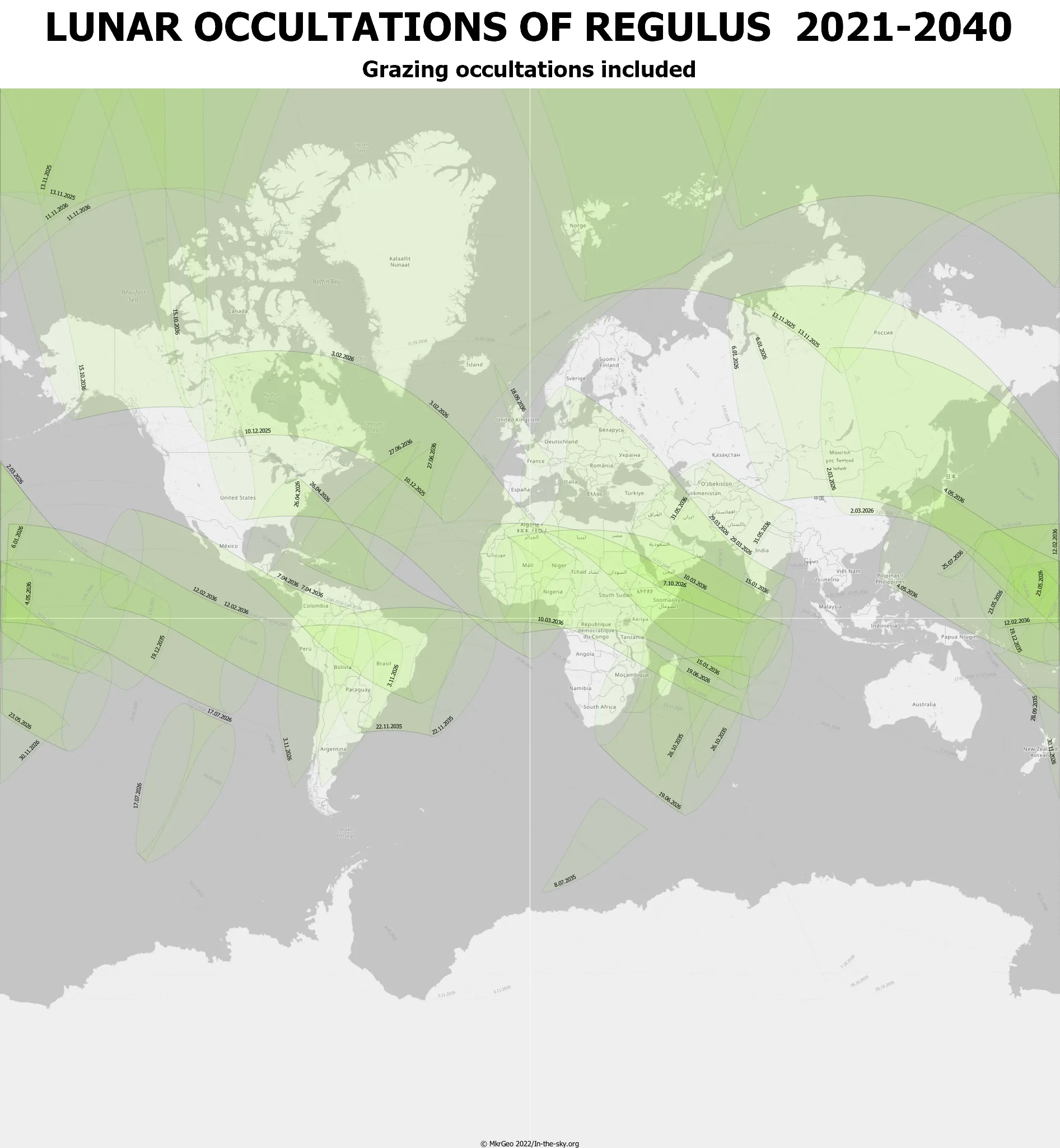
Pic. 9 The general map of lunar occultations of Regulus in the 2021-2040 period. Click to enlarge. Get extra-large maps.
The second closest star to the ecliptic line and brighter than 2 Mag is Spica. The ecliptic latitude of Spica is -2º03′, which also means 2 separate series of occultations in the period of 18,6 years. Spica is a first-magnitude star and the 16th-brightest star in the night sky. The middle of the occultation series is separated by 6.8 and 11.8 years. The first series will occur in 2024 and 2025, and the second one about 7 years later from 2031 to 2032 (Pic. 10). The total number of events in these series varies between 18 and 23 including daylight occultations.
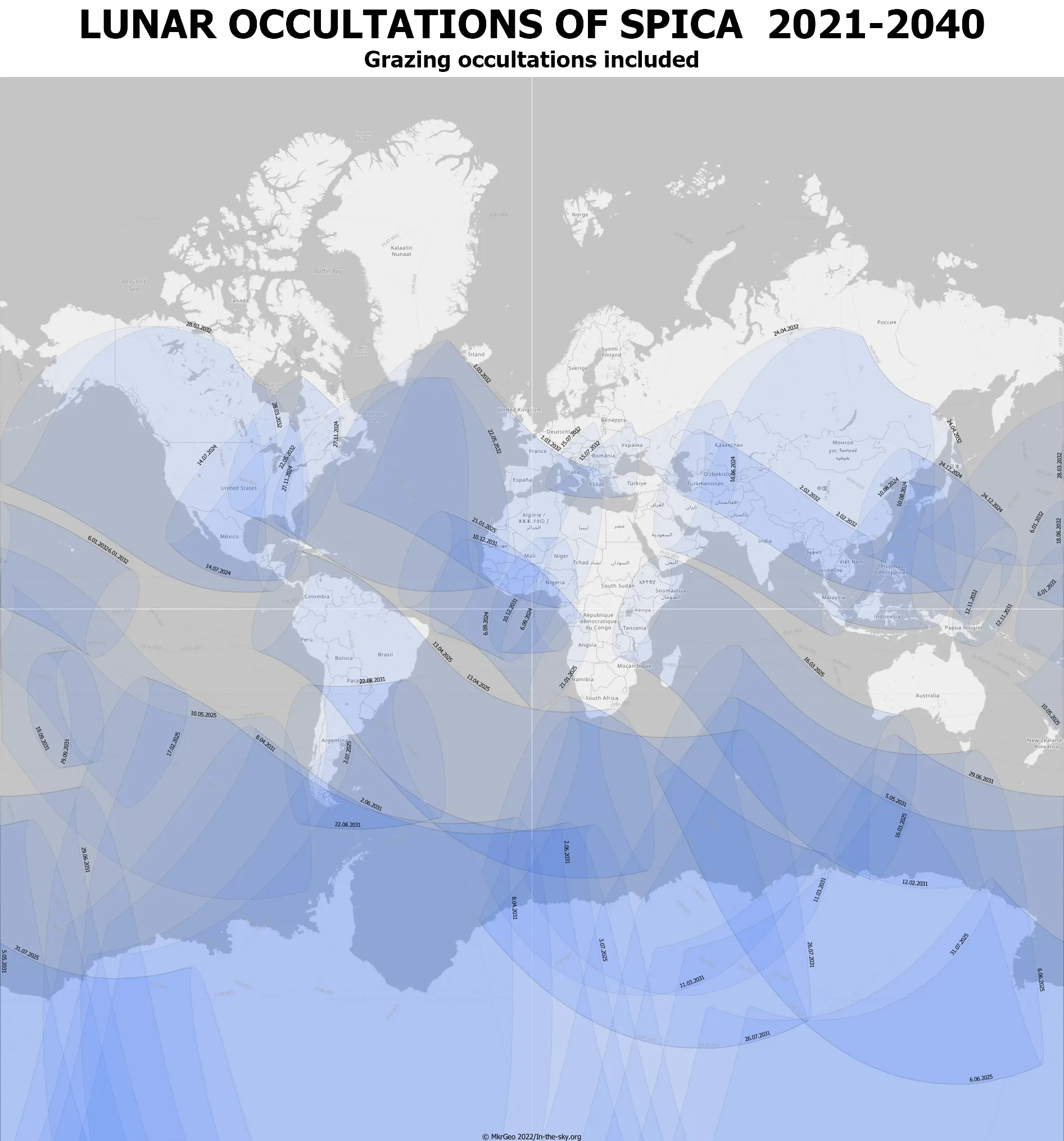
Pic. 10 The general map of lunar occultations of Spica in the 2021-2040 period. Click to enlarge. Get extra-large maps.
Other bright stars can be occulted just in one series across the 18,6-year period. The longest series applies to Antares, whose current ecliptic latitude is 4° 33′ 46.8″. The length of this series is about 5 years and counts 68-69 events. The one series of occultations means, that they predominantly don’t reach the opposite pole unless we deal with the ecliptic latitude roughly of +3º56′ or -3º56′. When the star is located further from the ecliptic, we have more areas in our globe, where the given occultation cannot be seen. The case of Antares is quite specific because it is located in the sky versus the time when this star is near its opposition. In fact, the occultations of Antares are geometrically visible up to about a latitude of 63º north, but the funniest thing is, that at this latitude Antares is never visible under proper night conditions. The northernmost areas, which accommodate the acceptable circumstances for the lunar occultation of Antares advance to the latitudes of about 55-57º north. In the following 18,6 period, the series of the lunar occultations of Antares started in the summer of 2023 and ended in the summer of 2028, while the completely daily occultations have been excluded (Pic. 11).
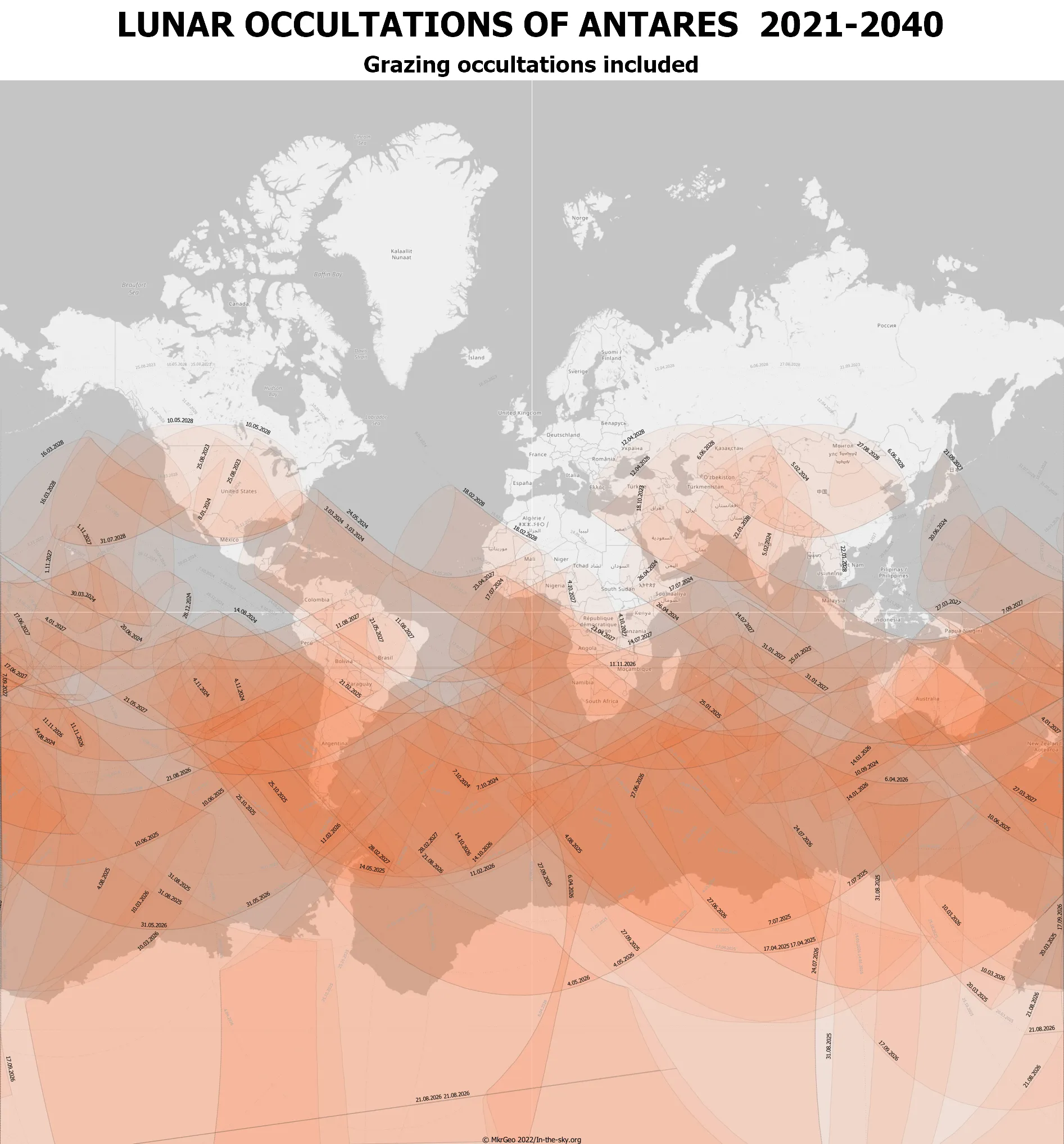
Pic. 11 The general map of lunar occultations of Antares in the 2021-2040 period. Click to enlarge. Get extra-large maps.
Interesting are also occultations of Elnath, which is in fact the faintest star from this group, placed as 27th the brightest in the night sky and 2nd brightest in the constellation of Taurus. It’s also the closest bright star to the galactic anti-center. The occultation event is still visible well from standard binoculars. The ecliptic latitude of +5º11’27” allows for a quite long series including 50-52 events in total. Because the location of the star is positive, the same as Antares the series proceeds from the south pole towards the northernmost limit, which in the case of Elnath is the latitude of 38º north (Pic. 12). However predominantly the occultation of Elnath can be seen up to latitude about 33-34º north, which means that the inhabitants of southern Europe cannot experience an event such as this in every 18,6 years period. The northernmost areas, from where the lunar occultation of Elnath can be visible are a result of the greatest lunar declination during the major lunar standstill and the maximum inclination of the lunar orbit possible. On top of that, the maximum monthly limit of lunar declination must fall at a similar right ascension to the Elnath star. Otherwise, the occultation will be observed further south than it could be. The best example is the comparison between the extreme lunar declinations of September 24, 2024 (+28°42.3′) and September 14, 2025 (+28°37.9′). The second extreme north lunar declination is more favorable for the more northern range of the Elnath occultation than the first one nearly a year earlier. A good example is the comparison of two places. Albuquerque city – the capital of New Mexico located at the latitude of 35° 6′ north will experience the lunar occultation of Elnath on September 14, 2025, whereas Bagdad located at the latitude of 33° 18′ north will not, despite higher lunar declination possible! This is because the Moon will reach its monthly declination peak about 1.5 hours later. It’s fairly enough to “push” the region of occultation visibility a few degrees south! Concluding, for instance in the southernmost part of Europe, the occultation of Elnath can be visible not every 18,6 years but just once for 18,6×3 = 45,8 years.
There is another specific thing related to the lunar occultations of Elnath, which is clearly visible on the map below. As has been explained earlier, the occultation of the Elnath star progresses from the south pole due to the positive ecliptic latitude of the star. However, the ecliptic itself at the Elnath’s right ascension reaches almost its northernmost equatorial latitude. Therefore the visibility of the Elnath star occultations by the Moon is limited by the Elnath’s visibility itself. The limit of β Tauri visibility is marked by the latitude of 61º23’33”. In conclusion, in the geometrical sense, we should have experienced more events in the Elnath occultation series if the star had been visible down to the south pole. The whole series counts over 4 years.
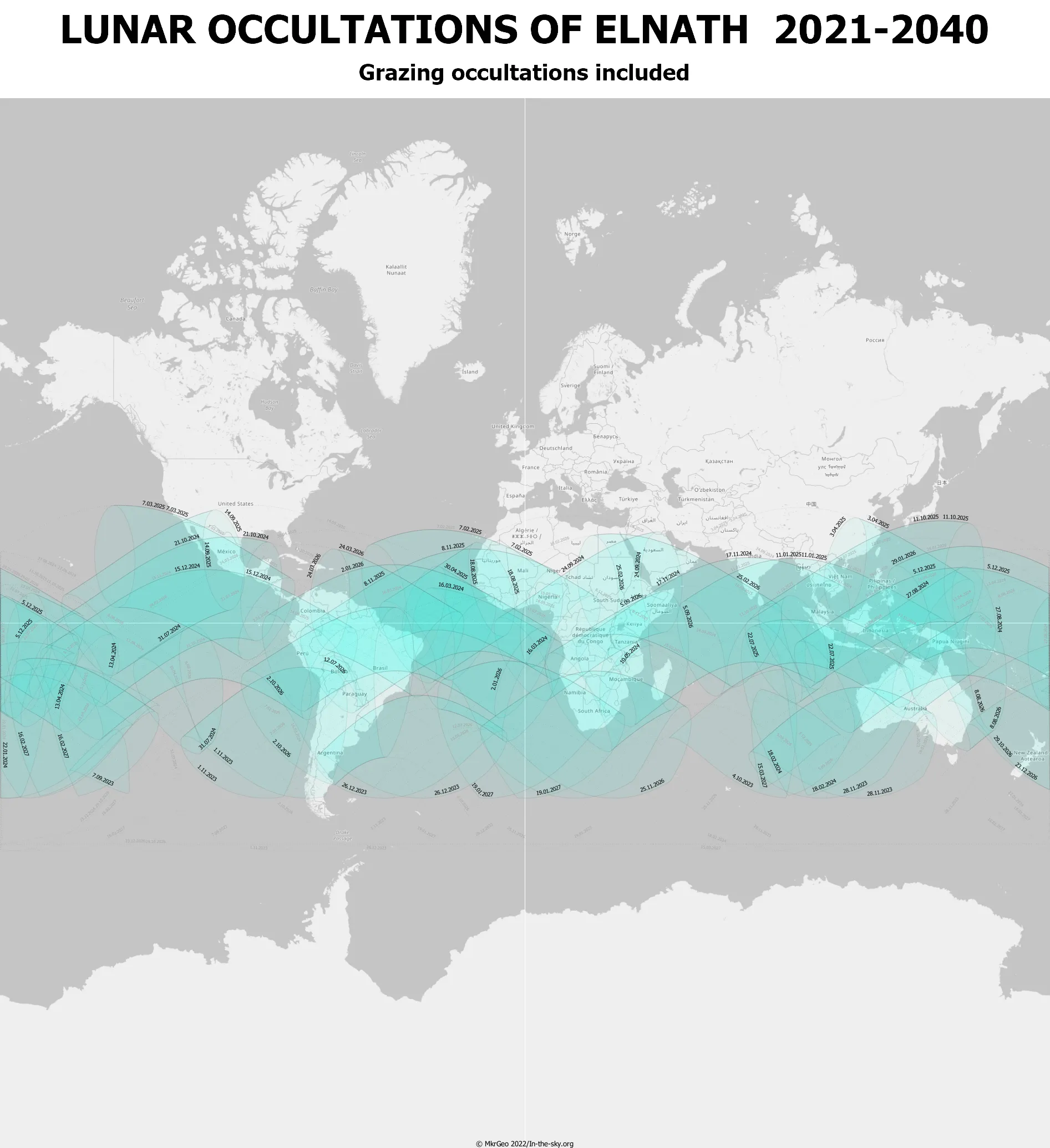
Pic. 12 The general map of lunar occultations of Elnathin the 2021-2040 period. Click to enlarge. Get extra-large maps.
Aldebaran has the furthest location from the ecliptic with the ecliptic latitude of -5º28′. Moreover, this is the brightest star in the night sky which can be occulted by the Moon. Its apparent brightness is 0,87 Mag, which makes its occultations quite spectacular in comparison to many other stars, which disappear behind the lunar disk. The occultation series of Aldebaran is typical mostly for the northern hemisphere due to its negative latitude against the ecliptic. The length of the Aldebaran occultation series is between 3,5 – 4 years with the total number of events between 44 and 49. The southernmost latitude for the lunar occultation of Aldebaran is 13º south. In turn, almost the whole of Australia and most of South America cannot observe an event such as this.

Pic. 13 The general map of lunar occultations of Aldebaran in the 2021-2040 period. Click to enlarge. Get extra-large maps.
You will be wondering why the given series of occultations has not fixed a number of events. There are the following reasons behind this (Koonen, Meeus, 1972):
– occultations fall in the proximity of the Sun, therefore aren’t classified as observable,
– because of the fluctuation of the lunar orbit inclination, some occultations might be missing at the beginning and at the end of the series.
7. LONG-TERM CHANGES IN THE OCCULTATION SERIES
The occultation series described the 5 brightest stars, as well as the occultation series typical for other, less bright stars, are subject to constant changes, which are rather not noticeable within human life. There are 2 deciding things here:
– the proper motion of the star against the Solar System (one of the most noticeable here is Arcturus, which changes its position by 2,2″ per year),
– the axial precession of the Earth, which results in the gradual change of the ecliptic plane. It results in slow changes of the star’s ecliptic latitudes and therefore the conditions at which they can be occulted by the Moon, how long can they be occulted, or even if can be occulted at all.
Tab.2 – Changes in the ecliptic latitude of the 4 brightest stars between 1950 and 2050 (Koonen, Meeus, 1972).
Looking at the table above (Tab. 2) we can clearly see the changes in the location of the stars against the ecliptic line, just within 100 years. It’s not hard to imagine what these changes can look like when we consider thousands of years. From the 5 brightest stars described here:
– Regulus and Spica tend to have their 2 occultation series extended in the future as move further from the ecliptic line,
– Elnath (not included in the table) will have a similar length of the occultation series because the star lies near the northernmost part of the ecliptic line, which will be least affected by changes within the following 100 years,
– The Antares series of occultations will be gradually shortened because the star moves further from the ecliptic line
– Aldebaran appears to inch towards the ecliptic, so finally, its occultations should be visible further south in the future and obviously last slightly longer
There are also bright stars, which were occulted by the Moon in historical times. The best example is the Pollux star, the last occultation was on September 30, 110 BC (Pic. 2). Due to the precession of the Earth, we might wait over 20000 years before this star will be occulted by the Moon again. However, the star itself will change its position after this time too, which will affect the occultations circumstances too. The same applies to the inclination of the Earth’s orbit, which is also subject to changes. Another example that refers to the fainter star, which is in fact not included in this article, but is already nearly the end of its occultation series is δ Saggitari (Kaus Meridionalis) with a magnitude of 2,70. This star will share the Pollux’s fate on October 1, 2359, and won’t be occulted at all afterward. The last 2 occultations will be just grazing occultations near the star’s visibility limit in the northern hemisphere.
It’s worth to mention also about another factor, in the long-term period that will affect the occultation series conditions. This is decreasing the most extreme values of lunar declination driven by the secular diminution of the obliquity of the ecliptic. The mean obliquity was 23º27’08” in 1900 and will be just 23º25’35” in 2100 (Meeus, 1997).
8. SUMMARY
This article presents the occultation series for the 5 brightest stars in the night sky, which in fact are brighter than 2Mag and have been described in earlier text here. The maps present all the events of the occultation series, which happened at night at least in peace. The complete daylight occultations haven’t been included here, because there is rather no chance to see them with ease. The length of the occultation series and the number of events visible by the naked eye or not (daylight) refer to the entire globe. It means, that an event such as this might be not visible at all from the given location or visible only very occasionally. The most spectacular occultation refers to Aldebaran, which is the brightest star, which can be hidden by the Moon. It’s also the most frequently occulted star in the northern hemisphere, where the majority of the people live, thus most ancient research is based on the occultation of this particular star. The described period covers roughly the time between May 2022 (the time when this article is produced) and early January 2041, all the occultations mentioned here fit the 2021-2040 period then. Apart from the brightest star, we can check the occultations of other bright stars down to the magnitude of 3.5, which usually are listed on a yearly basis here. Both the overall map and detailed circumstances are provided. The subject of the star’s occultation is much wider than “touched” here. We have a lot of situations, where the stars are hidden by asteroids for a short time. This is in fact a slightly different character of scientific investigation, which might be potentially another topic on this blog in the future.
Mariusz Krukar
References:
- Bohm-Vitense E., 1989, Introduction to stellar astrophysics, Cambridge University Press, Cambridge.
- Brian L., et al, 2019, Lunar Occultation Observations of Double Stars – Report #7, (in:) Journal of Double Star Observations, vol.15, no. 4, p. 503-520.
- Chemin Y. H., 2019, Lunar Science, Intech Open, London, UK
- Ci-Yuan L., The secular variation of the earth’s rotation obtained from 171 Chinese records of lunar occultation before A.D. 600, (in:) Acta Astrophysica Sinica, vol. 8, 1988, p. 147-155 Chinese Astronomy and Astrophysics, vol. 12, Sept. 1988, p. 260-267.Translation
- Dunham D.W., 2007, Occultations, Northern Virginia Astronomy Club Meeting (NOVAC), IOTA, PowerPoint presentation
- Eagle D., 2014, From Casual Stargazer to Amateur Astronomer: How to Advance to the Next Level, Springer Science + Business Media, New York
- Jordi C., Rosselo G., 1989, Fluctuations of the Earth’s Rotation by Stellar Occultations, (in:) Inertial Coordinate System on the Sky, Proceedings of IAU Symposium No. 141 held 17-21 October 1989 in Leningrad, USSR. Edited by J.H. Lieske and V.K. Abalakin. Dordrecht: Kluwer Academic Publishers, p.203
- Koonen G.P., Meeus J., 1972, Occultation series of five stars, (in:) Journal of the British Astronomical Association, Vol. 82, p. 431 – 433
- Meeus J., 1997, Mathematical Astronomy Morsels, Willmann-Bell, Inc., Richmond, Virginia
- Nugent R., 2007, The complete guide to observing lunar, grazing and asteroid occultations, International Occultation Timing Association
- Richichi A., Glindemann A., 2012, Advances in the interpretation and analysis of lunar occultation light curves, (in:) Astronomy & Astrophysics, v. 538.
- Roth G.D., 1994, Handbook of practical astronomy, Springer-Verlag, Berlin-Heidelberg
- Soma M., Tanikawa K., 2016, Earth rotation derived from occultation records, (in:) Publications of the Astronomical Society of Japan, Volume 68, Issue 2, April 2016, 29
- Stephenson F.R., Morrison L.V., 1995, Long-Term Fluctuations in the Earth’s Rotation: 700 BC to AD 1990, (in:) Physical Sciences and Engineering Vol. 351, No. 1695 (Apr. 15, 1995), pp. 165-202
- Stephenson F.R., Morrison L.V., Hohenkerk C.Y., 2016, Measurement of the Earth’s rotation: 720 BC to AD 2015, (in:) Proc Math Phys Eng Sci. 2016 Dec; 472(2196)
- Tanikawa K., Soma M., 2014, Historical astronomy and eclipses, (in:) Intensive Workshop on Ancient and Medieval Eclipse Data, Tokyo
- Tayler R. J., 1994, The stars: their structure and evolution, Cambridge University Press, Cambridge
- Vrbik J., 2010, New methods of celestial mechanics, Department of Mathematics, Brock University, Canada
- Wlasuk P.T., 2000, Observing the Moon, Springer-Verlag London
Links:
- The International Occultation Timing Association
- https://occultations.org/
- https://iota-es.de/
- Lunar occultations of bright stars possible to see from Brunei in the 2020-2029 period.
- Occultations of planets by the Moon
- Archive of lunar occultation observations (AD 1623 onwards)
- What is an occultation?
- https://poyntsource.com/
- http://www.poyntsource.com/Richard/double_stars.htm
- https://www.britannica.com/science/eclipse/Lunar-research
- Observing lunar occultations of double stars
- Video recording and analysing lunar occultations of double stars
- Lunar Occultations of Close Double Stars
- https://www.britannica.com/science/eclipse/Lunar-research
- New frontiers in Earth rotation, miscellaneous topics and discussions
- http://www.perseus.gr/Astro-Lunar-Parallax.htm
- https://epod.usra.edu/blog/2006/10/lunar-standstill-and-saros-cycle.html
- Occultations of stars by the Moon
- Diffraction effects during a lunar occultation
- Lunar parallax explained
- A Guide to Supermoons and Mini-Moons through 2060
- https://theconversation.com/watch-the-bright-star-regulus-hide-behind-the-full-moon-72744
- Lunar limb profiles from occultation observations
Forums:
- https://www.quora.com/What-is-the-Fresnel-diffraction
- https://www.cloudynights.com/topic/800320-lunar-occultation-maps/
- https://www.physicsforums.com/threads/what-is-the-cause-of-lunar-nodal-and-apsidal-precession.851208/
- https://astronomy.stackexchange.com/questions/43420/lunar-inclination
Wiki:
- Angular_diameter
- Ecliptic
- Fresnel_diffraction
- Grazing_lunar_occultation
- Libration
- Lunar_precession
- Lunar_standstill
- Nodal_period
- Nodal_precession
- Occultation
- Orbital_inclination
- Topography_of_the_Moon
Software:
- Occult v4.12.x.x
- OccultWatcher
- AstroPlanner
- Limovie – Light Measurement tool for Occultation observation using VIdeo rEcorder
Youtube:
